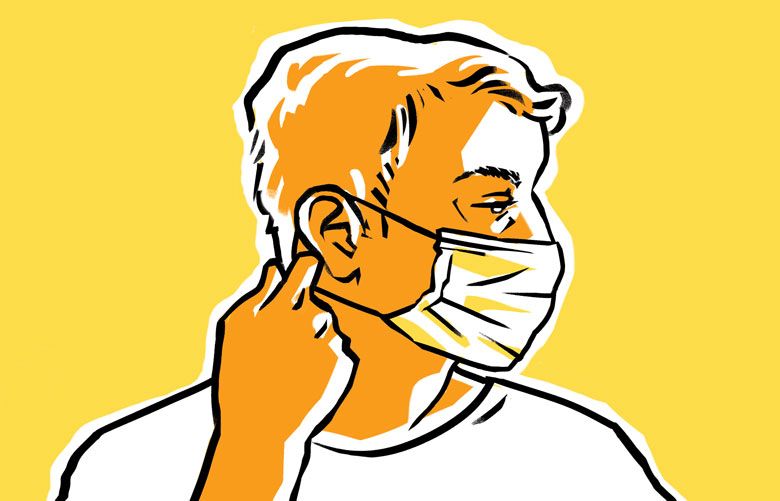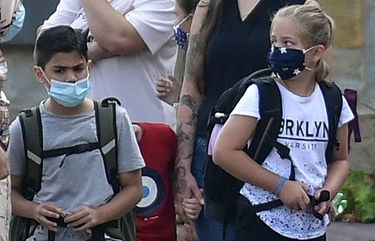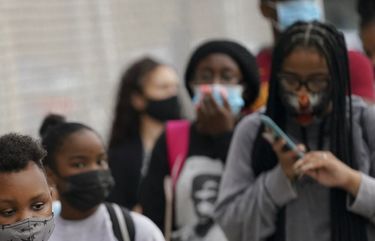Wearing face coverings in public is the new normal — they may not be convenient, but we’re adjusting to them as an easy way to protect each other. They’ve even become fashion accessories, with major retailers selling packs of colorfully designed masks so you can stock up and have enough masks to wear a new one on every outing and toss it in the laundry when you get home.
But masks come with challenges. It can be tough to get children to wear them — and wear them correctly. They’re occlusive, so acne-prone people can experience breakouts from wearing them all day. And with the Pacific Northwest’s notorious rainy season on its way, do we need to worry about our masks getting wet?
This week’s FAQ Friday focuses on some of the most common face-covering quandaries.
What happens if my mask gets wet?
Whether it’s saliva, sweat or any other form of moisture, a wet face covering is not ideal, according to experts.
“You want the air to pass through the mask, because you do not have a tight seal around the face like a fitted N95 does,” Michael Knight, an assistant professor of medicine at George Washington University, told The Washington Post in August. “If the mask is saturated with fluid, then that fluid is in the fabric of the mask, and air is not going to pass through that.”
When single-use surgical masks get wet, they “fall apart,” said Neysa Ernst, nurse manager of the Biocontainment Unit at Johns Hopkins Medicine.
She adds that even sturdier N95 masks can also start to degrade if exposed to too much moisture. That’s why health-care workers who wear them on a daily basis often store them in paper bags.
“The paper bag will then absorb some of the moisture that naturally occurs in the mask and so then you can reuse the mask,” Ernst says.
If you’re going to be out and about and there’s a chance you might get caught in the rain, have a hood and/or umbrella, and bring an extra mask so you can replace yours if it gets damp.
How do I get my child to wear a mask?
In addition to fitting properly, children’s masks have to be comfortable, Ernst says.
“If it’s uncomfortable, they’re going to take it off the minute that you walk out the door or they’re going to push it down below their chins,” she says.
Monica Gandhi, a professor of medicine and an infectious-disease expert at the University of California, San Francisco, suggests using adjustable face coverings, which can give children “some sense of control.” She also recommends looking for masks with playful designs such as rainbows or superheroes, or matching a child’s face covering to their outfits.
“Make it fun,” she says.
But getting children to adjust to mask-wearing involves more than just picking the right covering, experts told Jennifer Davis in a recent Washington Post story. It takes planning and patience.
This might involve teaching children, especially younger ones, how to read emotions while wearing a mask, Rebecca Schrag Hershberg, a clinical psychologist, parenting coach and author, told Davis. Children should also be shown good mask-care habits, such as how to put their mask on a clean paper towel or in a clean paper bag or plastic container when they have to take it off, Davis reported.
Throughout the period of adjustment, Hershberg and other experts said parents or guardians should be patient, provide positive reinforcement and validate how their children may be feeling.
“It’s not helpful to say things like, ‘It’s not that bad,’ or ‘Come on, what’s the big deal?’” Hershberg said. “It’s far better to acknowledge that this is different and does feel weird, but that it’s also important and something we need to do for the health of our community.”
What do I do if my mask gives me acne?
Skin irritation and breakouts caused by mask-wearing have become so common during the pandemic that the term “maskne” was added to Urban Dictionary, The Washington Post’s Danielle Braff reported in June.
“Virtually all skin types will see some form of irritation from wearing a face mask if they are wearing them for extended amounts of time each day,” Dendy Engelman, a dermatologic surgeon in New York, told Braff. “Many people will see irritation from the physical friction and/or pressure of the material on their skin, while others will see acne pop up.”
It’s similar to the acne that athletes sometimes experience when, say, a helmet or baseball cap fits snugly, according to Dr. Ata Moshiri, who sees patients at the UW Meidcal Center’s Dermatology Clinic.
But getting it because of wearing a mask “feels like a crummy side effect of doing the right thing — a raw deal, to be sure,” Moshiri said in a recent UW Medicine blog post.
If you are experiencing “maskne,” it can be tempting to throw a lot of products at the problem, but that could actually further aggravate your skin, Moshiri says. “Now is the time to simplify your skin care routine.”
Use a gentle cleanser and products designed to hydrate, repair and support the skin’s barrier function, Engelman said. Skin irritation caused by friction can be alleviated with moisturizing ointments, and cleansers containing salicylic acid, benzoyl peroxide or elemental sulfur are recommended for treating breakouts, Braff reported.
It is best to avoid wearing makeup, which can soil your mask and clog your pores.
Skin experts also recommended paying attention to the type of mask you’re wearing and making sure to keep it clean. Adam Mamelak, an Austin-based dermatologist, says to look for one with multiple layers of silk or silk lining. Silk has antimicrobial properties and has been shown to be better for people with sensitive skin, Braff reported.
Information from The Washington Post is included in this report.
You can read last week’s FAQ Friday, which explained how COVID-19 affects some people long after they’re diagnosed, at st.news/faq-longhaulers. If you have a question you haven’t seen addressed in The Seattle Times’ coverage, ask it at st.news/coronavirus-questions or via the form below.


